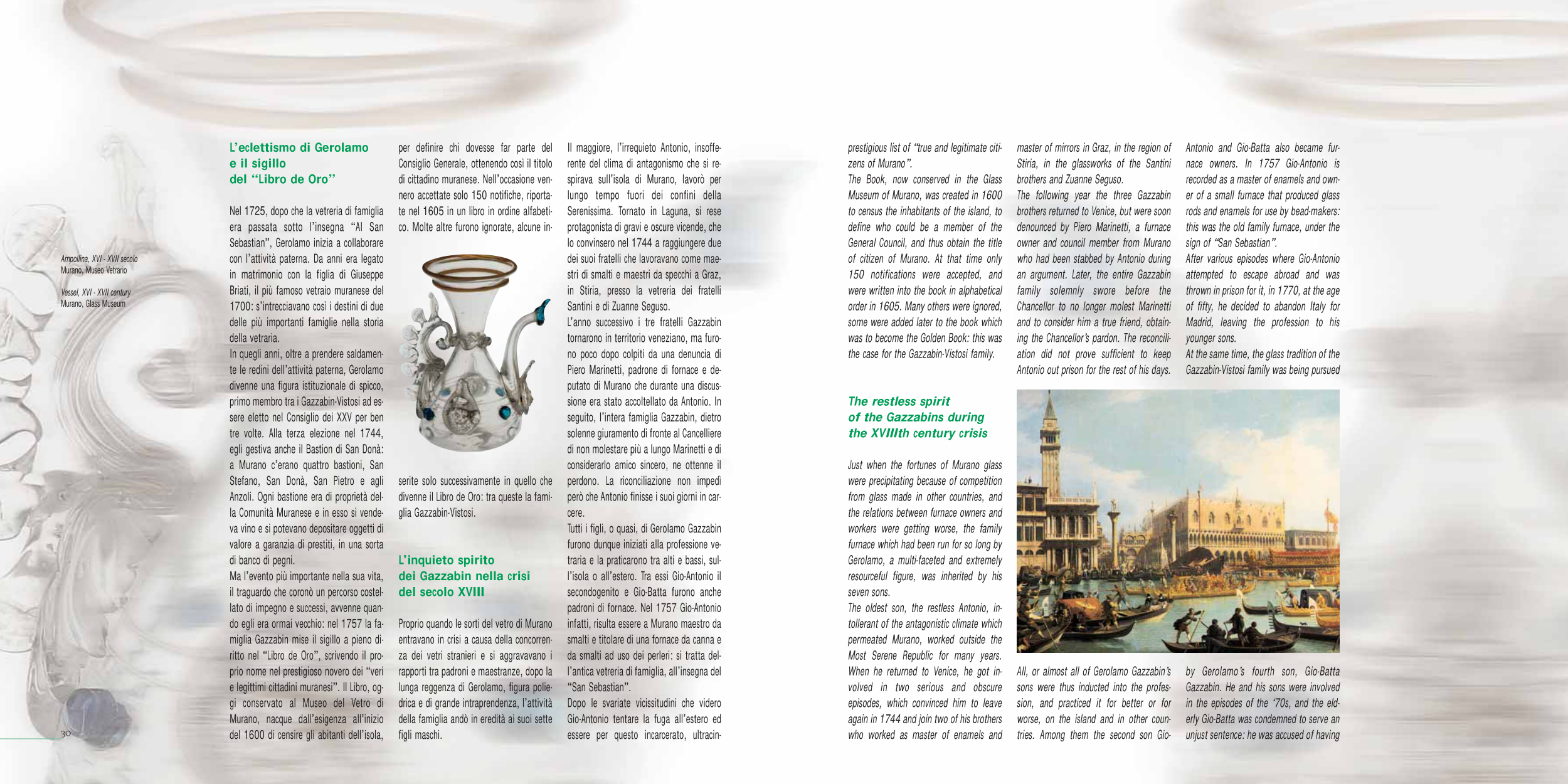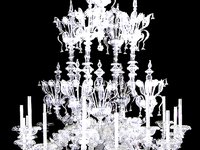prestigious list of “true and legitimate citi-
zens of Murano”.
The Book, now conserved in the Glass
Museum of Murano, was created in 1600
to census the inhabitants of the island, to
define who could be a member of the
General Council, and thus obtain the title
of citizen of Murano. At that time only
150 notifications were accepted, and
were written into the book in alphabetical
order in 1605. Many others were ignored,
some were added later to the book which
was to become the Golden Book: this was
the case for the Gazzabin-Vistosi family.
The restless spirit
of the Gazzabins during
the XVIIIth century crisis
Just when the fortunes of Murano glass
were precipitating because of competition
from glass made in other countries, and
the relations between furnace owners and
workers were getting worse, the family
furnace which had been run for so long by
Gerolamo, a multi-faceted and extremely
resourceful figure, was inherited by his
seven sons.
The oldest son, the restless Antonio, in-
tollerant of the antagonistic climate which
permeated Murano, worked outside the
Most Serene Republic for many years.
When he returned to Venice, he got in-
volved in two serious and obscure
episodes, which convinced him to leave
again in 1744 and join two of his brothers
who worked as master of enamels and
master of mirrors in Graz, in the region of
Stiria, in the glassworks of the Santini
brothers and Zuanne Seguso.
The following year the three Gazzabin
brothers returned to Venice, but were soon
denounced by Piero Marinetti, a furnace
owner and council member from Murano
who had been stabbed by Antonio during
an argument. Later, the entire Gazzabin
family solemnly swore before the
Chancellor to no longer molest Marinetti
and to consider him a true friend, obtain-
ing the Chancellor’s pardon. The reconcili-
ation did not prove sufficient to keep
Antonio out prison for the rest of his days.
All, or almost all of Gerolamo Gazzabin’s
sons were thus inducted into the profes-
sion, and practiced it for better or for
worse, on the island and in other coun-
tries. Among them the second son Gio-
Antonio and Gio-Batta also became fur-
nace owners. In 1757 Gio-Antonio is
recorded as a master of enamels and own-
er of a small furnace that produced glass
rods and enamels for use by bead-makers:
this was the old family furnace, under the
sign of “San Sebastian”.
After various episodes where Gio-Antonio
attempted to escape abroad and was
thrown in prison for it, in 1770, at the age
of fifty, he decided to abandon Italy for
Madrid, leaving the profession to his
younger sons.
At the same time, the glass tradition of the
Gazzabin-Vistosi family was being pursued
by Gerolamo’s fourth son, Gio-Batta
Gazzabin. He and his sons were involved
in the episodes of the ‘70s, and the eld-
erly Gio-Batta was condemned to serve an
unjust sentence: he was accused of having
L’eclettismo di Gerolamo
e il sigillo
del “Libro de Oro”
Nel 1725, dopo che la vetreria di famiglia
era passata sotto l’insegna “Al San
Sebastian”, Gerolamo inizia a collaborare
con l’attività paterna. Da anni era legato
in matrimonio con la figlia di Giuseppe
Briati, il più famoso vetraio muranese del
1700: s’intrecciavano così i destini di due
delle più importanti famiglie nella storia
della vetraria.
In quegli anni, oltre a prendere saldamen-
te le redini dell’attività paterna, Gerolamo
divenne una figura istituzionale di spicco,
primo membro tra i Gazzabin-Vistosi ad es-
sere eletto nel Consiglio dei XXV per ben
tre volte. Alla terza elezione nel 1744,
egli gestiva anche il Bastion di San Donà:
a Murano c’erano quattro bastioni, San
Stefano, San Donà, San Pietro e agli
Anzoli. Ogni bastione era di proprietà del-
la Comunità Muranese e in esso si vende-
va vino e si potevano depositare oggetti di
valore a garanzia di prestiti, in una sorta
di banco di pegni.
Ma l’evento più importante nella sua vita,
il traguardo che coronò un percorso costel-
lato di impegno e successi, avvenne quan-
do egli era ormai vecchio: nel 1757 la fa-
miglia Gazzabin mise il sigillo a pieno di-
ritto nel “Libro de Oro”, scrivendo il pro-
prio nome nel prestigioso novero dei “veri
e legittimi cittadini muranesi”. Il Libro, og-
gi conservato al Museo del Vetro di
Murano, nacque dall’esigenza all’inizio
del 1600 di censire gli abitanti dell’isola,
per definire chi dovesse far parte del
Consiglio Generale, ottenendo così il titolo
di cittadino muranese. Nell’occasione ven-
nero accettate solo 150 notifiche, riporta-
te nel 1605 in un libro in ordine alfabeti-
co. Molte altre furono ignorate, alcune in-
serite solo successivamente in quello che
divenne il Libro de Oro: tra queste la fami-
glia Gazzabin-Vistosi.
L’inquieto spirito
dei Gazzabin nella crisi
del secolo XVIII
Proprio quando le sorti del vetro di Murano
entravano in crisi a causa della concorren-
za dei vetri stranieri e si aggravavano i
rapporti tra padroni e maestranze, dopo la
lunga reggenza di Gerolamo, figura polie-
drica e di grande intraprendenza, l’attività
della famiglia andò in eredità ai suoi sette
figli maschi.
Il maggiore, l’irrequieto Antonio, insoffe-
rente del clima di antagonismo che si re-
spirava sull’isola di Murano, lavorò per
lungo tempo fuori dei confini della
Serenissima. Tornato in Laguna, si rese
protagonista di gravi e oscure vicende, che
lo convinsero nel 1744 a raggiungere due
dei suoi fratelli che lavoravano come mae-
stri di smalti e maestri da specchi a Graz,
in Stiria, presso la vetreria dei fratelli
Santini e di Zuanne Seguso.
L’anno successivo i tre fratelli Gazzabin
tornarono in territorio veneziano, ma furo-
no poco dopo colpiti da una denuncia di
Piero Marinetti, padrone di fornace e de-
putato di Murano che durante una discus-
sione era stato accoltellato da Antonio. In
seguito, l’intera famiglia Gazzabin, dietro
solenne giuramento di fronte al Cancelliere
di non molestare più a lungo Marinetti e di
considerarlo amico sincero, ne ottenne il
perdono. La riconciliazione non impedì
però che Antonio finisse i suoi giorni in car-
cere.
Tutti i figli, o quasi, di Gerolamo Gazzabin
furono dunque iniziati alla professione ve-
traria e la praticarono tra alti e bassi, sul-
l’isola o all’estero. Tra essi Gio-Antonio il
secondogenito e Gio-Batta furono anche
padroni di fornace. Nel 1757 Gio-Antonio
infatti, risulta essere a Murano maestro da
smalti e titolare di una fornace da canna e
da smalti ad uso dei perleri: si tratta del-
l’antica vetreria di famiglia, all’insegna del
“San Sebastian”.
Dopo le svariate vicissitudini che videro
Gio-Antonio tentare la fuga all’estero ed
essere per questo incarcerato, ultracin-
30
Ampollina, XVI - XVII secolo
Murano, Museo Vetrario
Vessel, XVI - XVII century
Murano, Glass Museum













































































